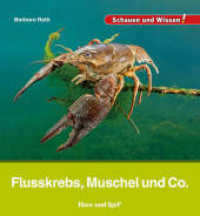基本説明
Presents robust and modern thermodynamic methods for determing the "functional energetics" of macromolecular structures with their biological functions.
Full Description
In the past several years, there has been an explosion in the ability of biologists, molecular biologists and biochemists to collect vast amounts of data on their systems. Biothermodynamics, Part C presents sophisticated methods for estimating the thermodynamic parameters of specific protein-protein, protein-DNA and small molecule interactions.
The use of thermodynamics in biological research is used as an "energy book-keeping system.” While the structure and function of a molecule is important, it is equally important to know what drives the energy force. These methods look to answer: What are the sources of energy that drive the function? Which of the pathways are of biological significance?
As the base of macromolecular structures continues to expand through powerful techniques of molecular biology, such as X-ray crystal data and spectroscopy methods, the importance of tested and reliable methods for answering these questions will continue to expand as well.
Contents
Measurement and Analysis of Equilibrium Binding Titrations: A beginner's guide
Dorothy Beckett
Macromolecular Competition Titration Method: Accessing Thermodynamics of the Unmodified Macromolecule - Ligand Interactions Through Spectroscopic Titrations of Fluorescent Analogs
Wlodzimierz Bujalowski and Maria J. Jezewska
Analysis of PKR-RNA interactions by sedimentation velocity
C. Jason Wong, Katherine Launer-Felty and James L. Cole
Structural and Thermodynamic Analysis of PDZ/Ligand Interactions
Tyson R. Shepherd and Ernesto J. Fuentes
Thermodynamic analysis of metal ion-induced protein assembly
Andrew B. Herr and Deborah G. Conrady
Thermodynamic Dissection of Colicin Interactions
Nicholas G Housden and Colin Kleanthous
Energetics of Src homology domain interactions in receptor tyrosine kinase-mediated signaling
John E. Ladbury and Stefan T. Arold
Structural and Functional Energetic Linkages in Allosteric Regulation of Muscle Pyruvate Kinase
J. Ching Lee and Petr Herman
Analysis of Free Energy versus Temperature Curves in Protein Folding and Macromolecular Interactions
Vince J. LiCata and Chin-Chi Liu
Application of the Sequential n-Step Kinetic Mechanism to Polypeptide Translocases
Aaron L. Lucius, Justin M. Miller and Burki Rajendar
A Coupled Equilibrium Approach to Study Nucleosome Thermodynamics
Andrew J. Andrews and Karolin Luger
Quantitative methods for measuring DNA flexibility in vitro and in vivo
Justin P. Peters, Nicole Becker, Emily M. Rueter, Zeljko Bajzer, Jason D. Kahna and L. James Maher
A Thermodynamic Approach for the Targeting of Nucleic Acid Structures Using Their Complementary Single Strands
Hui-Ting Lee, Caroline Carr, Hollie Siebler, Lela Waters, Irine Khutsishvili, Fany Iseka, Brian Domack, Chris M. Olsen, and Luis Marky
Thermodynamics of Biological Processes
Hernan G. Garcia, Jane Kondev, Nigel Orme, Julie Theriot and Rob Phillips
Protein stability in the presence of co-solutes
Luis Marcelo F. Holthauzen, Matthew Auton, Mikhail Sineva and Jorg Rosgen
Small Angle X-ray Scattering Studies of Peptide-Lipid Interactions using the Mouse Paneth Cell α-Defensin Cryptdin-4
Abhijit Mishra, Kenneth P. Tai, Nathan W. Schmidt, André J. Ouellette and Gerard C. L. Wong
Synergy of molecular dynamics and isothermal titration calorimetry in studies of allostery
Rebecca Strawn, Thomas Stockner, Milan Melichercik, Lihua Jin, Wei-Feng Xue, Jannette Carey and Rüdiger Ettrich
Using tryptophan fluorescence to measure the stability of membrane proteins folded in liposomes
C. Preston Moon1 and Karen G. Fleming
Non-B Conformations of CAG Repeats Using 2-aminopurine
Natalya N. Degtyareva and Jeffrey T. Petty
Disulfide bond-mediated passenger domain stalling as a structural probe of autotransporter outer membrane secretion in vivo
Jonathan P. Renn & Patricia L. Clark
Strategies for the Thermodynamic Characterization of Linked Binding/Local Folding Reactions Within the Native State: Application to the LID Domain of Adenylate Kinase from Escherichia coli
Travis P. Schrank, W. Austin Elam, Jing Li and Vincent J. Hilser














